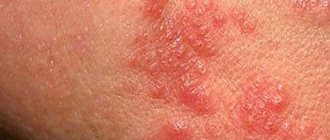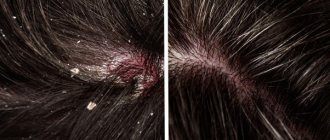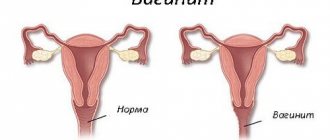Of all known skin diseases, atopic dermatitis is the most insidious. It is quite difficult to identify it, make an accurate diagnosis and treat it. The signs of atopic dermatitis, as a rule, do not differ from the symptoms characteristic of other skin pathologies, but they have some features. Often people do not even realize that they are sick; they try to cure skin irritation with ordinary cosmetics and folk remedies. Sometimes the symptoms go away, but after some time atopic dermatitis appears again with a number of complications. To avoid this, it is necessary to recognize dermatitis in time and understand the causes and mechanism of its development.
Causes of development of atypical dermatitis
Atopic dermatitis is an inflammatory, chronically relapsing pathology of the skin, accompanied by constant itching, as well as eczematous and lichenoid rashes. The disease is also called allergic eczema, as it very often occurs at the same time as:
- bronchial asthma;
- food allergies;
- allergic rhinitis;
- conjunctivitis;
- ichthyosis. [12]
Atopic dermatitis most often develops in childhood - the prevalence among children reaches 15-30%; in 9 out of 10 cases it develops in the first year of life. The incidence in adults is 2-10%. Women suffer from it more often than men. Most cases occur in cities with high levels of pollution and cold climates. [3]
This is an immune-dependent pathology. The reasons for its development are associated with mutations in genes that are responsible for the synthesis of filaggrin, a structural skin protein involved in the formation of the stratum corneum, which, in turn, is responsible for the barrier functions of the skin. Like a brick wall, the stratum corneum of the epidermis retains water and does not allow a large number of allergens and microorganisms to enter the body. In patients with dermatitis, the synthesis of filaggrin is impaired, and the connections between the cells of the stratum corneum are damaged. Because of this, the skin retains moisture worse and is more sensitive to any external influences. The mechanism is as follows: the pathogen enters the body through damaged skin, and the immune system produces immunoglobulins. Against the background of these processes, symptoms of atopic dermatitis arise. [4]
Skin application with SAFT nutrition test
SAFT is a food allergy testing method primarily used for young children. The technique involves eating the food that is suspected of causing the child's allergy and monitoring symptoms.
If erythema, itching and swelling of the skin occurs during use, this indicates a positive result, that is, an allergy. Most often, this test is carried out on allergenic fruits, vegetables, milk, chicken eggs and nuts.
Factors provoking the disease
A genetic mutation does not cause atopic dermatitis on its own. The disease develops under the influence of provoking factors. Most often these are atopenes - allergens to which the immune system produces antibodies. These include:
- food allergens - cow's milk, wheat, crayfish, crab, soy, chocolate, citrus fruits;
- pollen atopenes – wormwood, ragweed;
- dust pathogens - animal hair, dust, bed mites, molds. [5]
Some foods (smoked meats, sweets, hot spices, alcoholic drinks), medications (antibiotics, vitamins, sulfonamides) and cosmetics (perfumes, decorative cosmetics) can also lead to the development of atopic dermatitis in children and adults.
Factors due to which a person can develop dermatitis are divided into external and internal. Some of the external factors have already been mentioned, but they also include:
- climatic conditions;
- evaporation of solvents such as turpentine and acetone;
- harmful working conditions;
- environmental pollution with smoke and toxic fumes of aggressive substances. [5]
Internal factors are associated with other diseases of the gastrointestinal tract and endocrine system, as well as viral infections.
Many scientists believe that severe emotional stress and hormonal changes are also risk factors for developing atopic dermatitis. [6]
Determination of total concentration of IgE antibodies
The simplest test performed to diagnose AD is to determine the total concentration of IgE antibodies in the blood. This concentration is indicated in IU, and the standard is 100 IU/ml. In patients with atopy, the total concentration of IgE antibodies increases by 80%. There is often a relationship between IgE concentrations 10 times normal and the clinical condition of the patient's skin. The higher the antibody concentration, the worse and more severe the skin changes.
Therefore, patients with atopic dermatitis can be divided into two groups: those with elevated antibody levels and those with normal antibody levels (about 20% of patients).
- In the first case, we talk about extrinsic atopic dermatitis (extrinsic atopic dermatitis - EAD) because the symptoms are caused by allergens coming from the environment.
- Less commonly, we deal with intrinsic AD (intrinsic atopic dermatitis - IAD), where symptoms arise from non-immune causes, such as a skin defect or a nonspecific inflammatory response. This means that an IgE result within the normal range does not necessarily rule out atopic dermatitis.
Symptoms of atopic dermatitis
Depending on the age of patients with dermatitis, the symptoms of the disease can be very different. There are three phases of atopic dermatitis:
- infant - from 7-8 weeks to 1.5-2 years;
- children's - from 2 to 12-13 years;
- adults - from the onset of puberty and older. [6, 7]
Beginning in infancy, atopic dermatitis lasts until puberty, and even until the end of life, often with remissions of varying duration. As a rule, symptoms are most pronounced in infancy and early childhood. In infants, the symptoms of atopic dermatitis include dry, scaly and itchy plaques that appear on the head, forehead and cheeks, and the outer elbows and knees. In children over 2 years of age, the manifestations are more extensive - rash and redness, dryness and flaking of the skin, as well as constant itching of the affected skin, which becomes rougher and thicker. In this case, atopic dermatitis affects the elbow and knee folds, wrists, ankles, neck, and buttock folds. An exacerbation of the disease is observed at the ages of 7-8 years and 12-14 years. [8]
As for symptoms in adulthood, we are talking specifically about episodic exacerbations of atopic dermatitis after many years of remission. They are characterized by:
- inflammation that starts from the elbow or knee folds, the back of the neck and spreads to the arms;
- pronounced dry skin with very severe peeling;
- incessant itching. [8]
Atopy is not only a disease of the body
Atopic dermatitis is a disease that can have a negative impact on the patient's psyche. Children and adolescents diagnosed with AD are more likely to have problems being accepted in their community. It is difficult to explain to your peers where the red spots and scars come from after an exacerbation of the disease.
Fortunately, only about 30% of patients continue to have symptoms into adulthood. In the remaining 70%, the symptoms disappear completely or appear in a milder form, which the patient can control with the help of a good dermatologist.
Diagnosis of skin pathology
At the moment, there is no specific laboratory test that can detect atopic dermatitis. The diagnosis is made based on the symptoms present and an assessment of the severity of the disease. The severity of atopic dermatitis is determined using the SCORAD scale, which includes a number of objective and subjective criteria. The first includes the strength and prevalence of lesions, the subjective - the intensity of itching during the day and night. [9]
To establish atopic dermatitis, it is necessary to identify specific IgE antibodies to allergens. For this purpose, cutaneous patch tests are performed, but only if the patient has delayed-type hypersensitivity.
Atopic dermatitis is often confused with other diseases. To avoid mistakes, differential diagnosis is carried out using laboratory tests:
- detection of platelet pathology;
- determination of immune status;
- microscopy of scales. [9]
Sometimes, to distinguish atopic dermatitis from other pathologies, the localization of the rash is sufficient. So vulgar psoriasis affects the extensor surfaces, while the manifestations of atopic dermatitis are localized in the flexor areas.
Main goals and directions of therapy
AD is a chronic disease, so treatment should be gradual and long-term.
- Elimination of causally significant allergens with the prescription of diet therapy and control of adverse environmental factors;
- Elimination or reduction of inflammatory changes on the skin and skin itching.
- Restoring the structure and function of the skin (improving microcirculation and metabolism in lesions; normalizing skin moisture).
- Prevention of the development of severe forms of the disease, leading to a decrease in the quality of life of patients and their disability.
- AD is based on allergic inflammation, so the basis of treatment is antihistamines and anti-inflammatory drugs.
- Multiple organ lesions in AD require systemic basic therapy with antiallergic drugs.
- Identification and treatment of concomitant diseases that aggravate the course of AD. (treatment of pathologies of the digestive system, metabolite and antioxidant therapy, normalization of functional disorders of the nervous system, rehabilitation of foci of chronic infection).
Areas of AD therapy:
- diet therapy and elimination measures to eliminate causally significant allergens;
- systemic pharmacotherapy;
- antihistamines;
- membrane stabilizing drugs;
- drugs that normalize the functions of the digestive system;
- vitamins;
- immunomodulators;
- drugs that regulate the function of the ANS;
- preparations containing unsaturated fatty acids;
- antibiotics;
- systemic corticosteroids (for special indications);
- External therapy and rehabilitation.
Correction of immune disorders in AD
- Direct methods of immunocorrection are allergen-specific immunotherapy (ASIT), therapeutic plasmapheresis, and immunopharmacotherapy itself with corrective drugs, as well as the use of modern immunosuppressants.
- ASIT is the only method of therapeutic influence on all pathogenetically significant parts of the allergic process, which has a long-term preventive effect and allows for the reverse development of the pathological process, because at the same time, a decrease in nonspecific tissue sensitivity to the allergen is formed, hyperreactivity decreases, and signs of allergic inflammation are suppressed, which indicates a restructuring of the nature of the cellular and cytokine response from Th2 to Th1 - a response with a decrease in the content and production of Ig E.
Indications for ASIT are determined by a set of criteria:
- diffuse or widespread form of AD;
- moderate/severe;
- clinically significant sensitization to aeroallergens, confirmed on the basis of anamnesis, positive skin tests and/or detection of specific Ig E antibodies to a given allergen;
- hereditary burden of allergic diseases, especially respiratory allergies;
- hypersensitivity to one group of allergens.
What complications can there be?
If atopic dermatitis is not properly treated, the disease will develop and lead to complications. Like manifestations, the severity and severity of complications are directly related to the age of the patient. The infantile phase is characterized by complications of atopic dermatitis such as candidiasis and Kaposi's eczema herpetiformis. In childhood, staphylococcal impetigo, molluscum contagiosum and chronic papillomavirus infection are observed. Complications in the adult phase are represented by dermatophytosis and keratomycosis. [10]
Without treatment, atopic dermatitis can significantly reduce the quality of life of the patient and his family. Discomfort is primarily associated with a person’s appearance - with dermatitis, noticeable itchy spots appear on the body, which cause anxiety among others. And although atopic dermatitis cannot be contracted, people are wary of patients and do not want to come into contact with them. Patients experience a continuous desire to scratch the inflammation, so their posture and facial expression look tense and repulsive. Therefore, when it comes to dermatitis, one cannot fail to mention the neurotic and psychological syndromes that this disease entails.
What is atopy?
The content of the article
Atopy is an abnormal response of the body to an allergen, resulting in overproduction of IgE antibodies responsible for the allergic reaction. Atopic dermatitis belongs to the group of atopic diseases, like bronchial asthma, urticaria and hay fever.
Patients prone to atopy usually have several allergic diseases at the same time. The body of a person with AD responds to very low doses of allergen (molecules that can trigger an immune response) in the environment. The disease can be caused by many factors that surround us: dust mites, pollen from flowers, animals and food.
Treatment with Akriderm drugs
Akriderm preparations are products for the local treatment of manifestations of atopic dermatitis with a wide spectrum of action. Thanks to the combined composition, including a glucocorticosteroid, an antibiotic and an antifungal component, the products have several effects at once:
- anti-inflammatory;
- antiallergic;
- vasoconstrictor;
- antipruritic. [12]
Since atopic dermatitis can occur in both acute and chronic forms, Akriderm preparations are available in the form of ointments and creams. This allows you to choose the most appropriate remedy based on the course of the disease, the severity of manifestations and the presence of secondary infection. Active substances penetrate deeply into the source of inflammation, fighting not only pathogens that provoke atopic dermatitis. Treatment is also aimed at combating attached microorganisms. Thus, Akriderm preparations have a bacterial and antifungal effect. [13]
A well-thought-out formulation of the drugs makes it possible to use them in the treatment of atopic dermatitis in children over 2 years of age. [14, 15]. Other advantages of Akriderm preparations for the topical treatment of atopic dermatitis include:
- convenient release form – 15 g and 30 g;
- reasonable price - the cost of a 30 g package is more profitable for the buyer compared to 15 g of a similar product; [16]
- over-the-counter status, which makes Akriderm preparations one of the most accessible means for treating manifestations of dermatitis.








